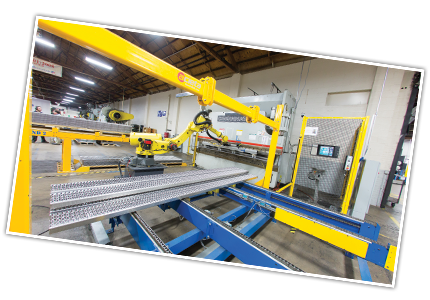In recent years, we’ve been getting the question much more frequently: Is it better to work with a single-source robotic integrator or a robotics OEM when choosing a new or retrofitted robot/machine tool system?

There are more robotic integrators and OEM robotic integrations available than ever before. This presents a challenge for prospective buyers who are weighing the options. Their shop may already have a number of different press brake brands, or they may have managed to stay loyal to the brand that got them started. The dilemma is whether to make use of the asset already owned (retrofit the robotic cell to an existing brake) or go with an entirely new system.
There are standard offerings from the larger press brake OEMs, as well as smaller automation houses working on projects to integrate robotic and/or hard automation wherever they can win the opportunity. Beyond these more conventional paths, there are also established servicing robotic integrators who have developed a focus on manufacturing disciplines instead of using a single brand or type of machine. Their collective approach is to integrate new fabrication equipment and retrofit the shop’s existing machines alike, often combining multiple types of processes within the respective disciplines, such as fabrication and machining. The choice will typically come down to philosophy in many cases.
The OEM
A machine tool OEM will integrate a robot to sell a standard solution. This approach can be effective where the standard layout is a good fit for the factory floor space and the work fits the parameters of the system’s capabilities. It’s also helpful if the OEM already has been used in the shop, simplifying the learning curve, utilizing the same programming software for the brake and maybe even the same style of brake tooling (i.e. WT-style, European, American, etc.).
The Integrator
A collective integrator has the capability of integrating new brakes purchased from various builders or brakes already on the shop floor, as well as other types of processes that may be useful in the new cell (i.e. machining, marking, inspection, etc.). They are likely to have a more diverse range of experience resulting in a larger field of view of the manufacturing process to uncover more automation opportunities in different parts of the business. It can often happen that the off-the-shelf package offered by the OEM will not quite fit the customer’s needs. A collective integrator can fit the cell to the needs of the shop, integrating other types of equipment into that cell - consolidating operations and eliminating some routings and stations in the shop altogether.
Thinking beyond the immediate consideration of the press brake cell, does your company want to find ways to use a connected system of part sorting, cutting tables, welding, machine tending, of palletizing, deburring, inspection and/or material handling?
For the short-term, an OEM will deliver a familiar and effective press brake solution. For a long-term benefit that aims to improve efficiency across the entire manufacturing process, a robotic integrator can address broader needs to optimize operations.
Contact us today!
info@acieta.com | (844) 422-4382